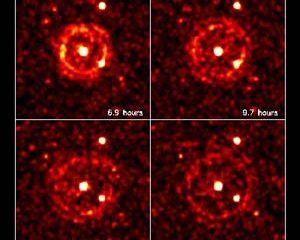Physics and Astronomy
This area deals with the fundamental laws and building blocks of nature and how they interact, the properties and the behavior of matter, and research into space and time and their structures.
innovations-report provides in-depth reports and articles on subjects such as astrophysics, laser technologies, nuclear, quantum, particle and solid-state physics, nanotechnologies, planetary research and findings (Mars, Venus) and developments related to the Hubble Telescope.

Counting atoms that aren’t there, in stars that no longer exist
Argonne researchers use specialized instrument
Researchers at the U.S. Department of Energy’s Argonne National Laboratory have reached for the stars – and seen what’s inside.
Argonne scientists, in collaboration with colleagues at the University of Chicago, Washington University and the Universita di Torino in Italy, examined stardust from a meteorite and found remnants of now-extinct technetium atoms made in stars long ago.
The stardust grains are tiny bit
NIST/University of Colorado Scientists create new form of matter: A fermionic condensate
Scientists at JILA, a joint laboratory of the Department of Commerce’s National Institute of Standards and Technology (NIST) and the University of Colorado at Boulder (CU-Boulder) report the first observation of a “fermionic condensate” formed from pairs of atoms in a gas, a long-sought, novel form of matter. Physicists hope that further research with such condensates eventually will help unlock the mysteries of high-temperature superconductivity, a phenomenon with the potential to improve energy ef

A new window for the study of exotic atomic nuclei.
On Friday the 30th, during the XLII international winter meeting on nuclear physics at Bormio, the first results will be announced of Finuda experiment (Nuclear Physics at Daphne), settled in Frascati at Infn National Laboratories.
Planned and made operating by a group of about forty physicists from Universities and Infn Sites of Bari, Brescia, Frascati, Pavia, Torino and Trieste, Finuda is devoted to the study of hypernuclei: nuclei composed by three different kinds of particles rather the

X-ray shout echoing through space
ESA’s X-ray observatory, XMM-Newton, has imaged a spectacular set of rings which appear to expand, with a speed a thousand times faster than that of light, around the point in the sky where a powerful gamma-ray explosion took place in early December. This is the first time that such a fascinating event, called an `echo’, has been seen in X-ray wavelengths.
This echo forms when the powerful radiation of a gamma-ray burst, coming from far away, crosses a slab of dust in our Galaxy and is sca

Rosetta – a new target to solve planetary mysteries
Rosetta is scheduled to be launched on board an Ariane-5 rocket on 26 February from Kourou, French Guiana.
Originally timed to begin about a year ago, Rosetta’s journey had to be postponed, as a precaution, following the failure of a different version of Ariane-5 in December 2002. This will be the first mission to orbit and land on a comet, one of the icy bodies that travel throughout the Solar System and develop a characteristic tail when they approach the Sun.
This del

The Pentaquark: The Strongest Confirmation to Date
An international team of physicists has provided the best evidence to date of the existence of a new form of atomic matter, dubbed the “pentaquark.” The research team confirmed the existence of pentaquarks by using a different approach that greatly increased the rate of detection compared to previous experiments. The results are published as the cover story in today’s issue of the journal Physical Review Letters.
“The latest, and most conclusive evidence of this five-quark particle — the ‘pe